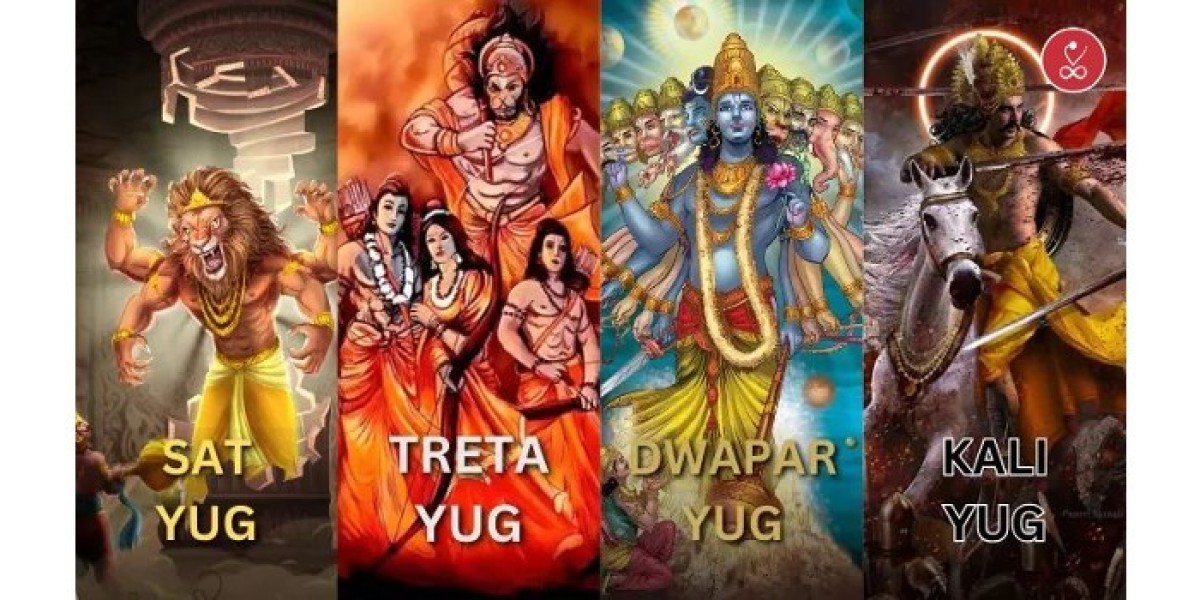Introduction
Ever wondered about the cyclical nature of time in Hindu mythology? Yugas are central to this idea, dividing time into four distinct ages. Each Yuga, with its unique characteristics, is marked by the appearance of divine beings known as Avatars. These Avatars are incarnations of the Hindu god Vishnu, who descends to earth to restore cosmic order. Let's dive into the fascinating world of the 4 Yugas Avatars.
Satya Yuga: The Age of Truth
Satya Yuga, often called the Golden Age, is a period of purity, righteousness, and harmony. It is the era when virtue reigns supreme and humanity perfectly coexists with nature.
Characteristics of Satya Yuga
In Satya Yuga, truth and justice prevail. People are spiritually advanced, and there is no need for laws or punishment because everyone follows dharma (righteousness) naturally. Life spans are the longest, and suffering is minimal.
Avatars of Satya Yuga
Matsya Avatar
Matsya, the fish incarnation, is Vishnu's first Avatar. He saves the Vedas (sacred texts) and the sage Manu from a great deluge, ensuring the continuity of wisdom and knowledge.
Kurma Avatar
In the Kurma Avatar, Vishnu takes the form of a tortoise. This Avatar supports Mount Mandara during the churning of the ocean, a pivotal event leading to the creation of divine nectar.
Varaha Avatar
Varaha, the boar incarnation, rescues the earth (personified as the goddess Bhudevi) from the demon Hiranyaksha. This Avatar symbolizes the triumph of good over evil and the restoration of the earth.
Narasimha Avatar
The Narasimha Avatar, a half-man, half-lion form, is one of the most fearsome incarnations of Vishnu. He appears to protect his devotee Prahlada and destroy the tyrant demon Hiranyakashipu, showcasing the boundless compassion of the divine.
Treta Yuga: The Age of Silver
Treta Yuga, the second age, sees a gradual decline in virtue and increased human suffering. Despite this, it remains a time of significant heroism and divine intervention.
Characteristics of Treta Yuga
Treta Yuga is marked by the emergence of great civilizations and the establishment of societal norms and laws. Human lifespans shorten, and people need guidance to follow the path of righteousness.
Avatars of Treta Yuga
Vamana Avatar
Vamana, the dwarf Brahmin, is Vishnu's fifth Avatar. He cleverly subdues the demon king Bali, restoring the balance of power between gods and demons and securing the heavens.
Parashurama Avatar
Parashurama, the warrior-sage, is known for his fiery temper and mission to rid the world of corrupt Kshatriyas (warrior class). His incarnation emphasizes the importance of discipline and justice.
Rama Avatar
Rama, the prince of Ayodhya, is one of the most revered Avatars of Vishnu. His life and deeds, narrated in the epic Ramayana, exemplify ideal kingship, devotion, and the eternal struggle between good and evil.
Dvapara Yuga: The Age of Bronze
Dvapara Yuga is characterized by a further decline in virtue and the onset of chaos and confusion. This age witnesses the rise of some of the most iconic figures in Hindu mythology.
Characteristics of Dvapara Yuga
Dvapara Yuga's dharma is significantly weakened, and people experience more conflicts and moral dilemmas. However, it is also a time of great learning and the emergence of profound spiritual teachings.
Avatars of Dvapara Yuga
Krishna Avatar
Krishna, the eighth Avatar of Vishnu, is a central figure in the Mahabharata and the Bhagavad Gita. He plays a crucial role in the Kurukshetra war and imparts timeless wisdom on duty, righteousness, and devotion.
Balarama Avatar
Balarama, Krishna's elder brother, is revered for his immense strength and role in supporting and guiding Krishna. His life underscores the values of loyalty and brotherhood.
Kali Yuga: The Age of Darkness
Kali Yuga, the current age, is often called the Age of Darkness. It is a period marked by moral decline, materialism, and strife.
Characteristics of Kali Yuga
Kali Yuga is characterized by the near-complete erosion of dharma. Human lifespans are the shortest, and ignorance, greed, and violence are rampant. However, it is also an age where spiritual growth can be rapid for those who seek it.
Avatars of Kali Yuga
Kalki Avatar (Future Avatar)
Kalki Avatar, the prophesied tenth Avatar of Vishnu, is yet to appear. He is expected to come at the end of Kali Yuga to vanquish evil and restore cosmic order, ushering in a new Satya Yuga.
Significance of the Avatars Across the Yugas
Each Avatar of Vishnu serves a unique purpose, addressing their respective Yugas' specific challenges and moral dilemmas. They demonstrate the eternal presence and guidance of the divine in the human realm.
Purpose of Each Avatar
The Avatars illustrate different aspects of divinity and provide moral and spiritual lessons. Whether Matsya’s wisdom, Rama’s righteousness, or Krishna’s divine play, each incarnation teaches us to uphold dharma.
Lessons from the Avatars
The stories of the Avatars encourage us to cultivate virtues like compassion, bravery, devotion, and justice. They remind us that divine intervention can restore balance and harmony even in the darkest times.
Conclusion
The 4 Yugas Avatars offer profound insights into the cyclical nature of time and the continuous battle between good and evil. These divine incarnations shape the spiritual landscape of Hinduism and provide timeless lessons that are relevant even today. As we navigate through the challenges of Kali Yuga, the stories of the Avatars inspire us to strive for righteousness and spiritual growth.
FAQs
What are the 4 Yugas in Hindu mythology?
The 4 Yugas are Satya Yuga, Treta Yuga, Dvapara Yuga, and Kali Yuga. Each Yuga represents a distinct age with unique characteristics and varying levels of virtue and morality.
Who are the primary Avatars in each Yuga?
Satya Yuga: Matsya, Kurma, Varaha, Narasimha
Treta Yuga: Vamana, Parashurama, Rama
Dvapara Yuga: Krishna, Balarama
Kali Yuga: Kalki (future Avatar)
What is the role of the Kalki Avatar in Kali Yuga?
The Kalki Avatar is prophesied to appear at the end of Kali Yuga to eradicate evil and restore righteousness, marking the transition to a new Satya Yuga.
How do the Avatars influence Hindu beliefs and practices?
The Avatars of Vishnu play a central role in Hindu beliefs, embodying divine intervention and moral guidance. Their stories are integral to Hindu rituals, festivals, and spiritual practices.
Why are the Avatars important for understanding Hindu mythology?
The Avatars are essential for understanding the dynamics of cosmic order, the battle between good and evil, and the divine role in maintaining balance in the universe. They offer valuable lessons on virtue, duty, and devotion.








